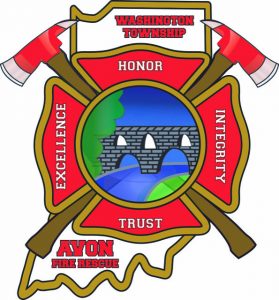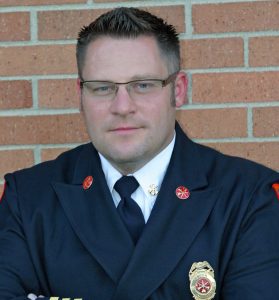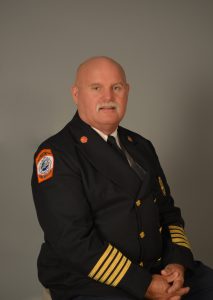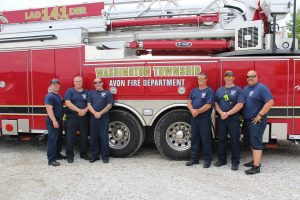Avon Fire Chief Talks Training Tactics, Saving Lives & Suicide Prevention
Writer / Christy Heitger-Ewing
Photography / Darren Boston
The Washington Township Avon Fire Department (WTAFD)started out in the mid-50s as a volunteer department and later progressed into a combination volunteer and career department before transitioning to full-time employees. Currently, the WTAFD employs 63 shift personnel and eight support staff across three stations. The station located on Rockville Road is the oldest of the structures.
Part of the original fire station still exists on the west end of the station. In the mid-90s, they added sleeping quarters and a kitchen. They are currently in the process of doing more upgrades to the building, including kitchen fire suppression systems and installing LED lighting.
In 1998, the town built another station on Ronald Reagan Parkway, then constructed a third one at Prestwick in 2004. In addition, last year the fire headquarters and township offices moved into a new building off of Rockville Road.
Through the years, firefighting has changed in many ways, starting with the number of responsibilities placed on firefighters. Years ago, their singular duty was to extinguish fires. Not so today where 85 percent of the runs involve performing EMS duties.
“We do advanced life support, basic life support, hazardous materials clean-up, you name it,” says Dan Smith, a firefighter for 34 years, 23 of them as Fire Chief in Avon. “No matter the emergency, we respond initially.”
Perhaps the most notable change is the gear. These days firefighters wear particulate hoods that offer the face and neck additional protection from soot and smoke. In addition, they don air packs, enabling them to enter burning buildings — something that Smith describes as a double-edged sword.
“While the added protection is great, we sometimes get more confident than we should in certain situations,” he says. “Before we fought fire outside the building. Now we go inside, which presents more potential for problems.”
That’s why the training aspect of the job is so critical. John Shafer, WTAFD’s Division Chief of Training & Safety, was hired a year and a half ago to make sure the department is ready to handle anything that’s thrown at them. He sets up weekly training sessions, each one focusing on a different area. For instance, one week might tackle hazardous materials, another week EMS/paramedics. There’s also officer development and, of course, hands-on firefighting drills.

 A key aspect to training is getting a chance to practice in conditions that are as close to real-life as possible. One way they do that is by running training drills in houses that homeowners have donated (these are typically structures that will eventually be torn down). Sometimes they build walls and set up furniture to make it more realistic. They then permeate the inside of the structure with non-toxic chemical smoke to simulate authentic firefighting conditions.
A key aspect to training is getting a chance to practice in conditions that are as close to real-life as possible. One way they do that is by running training drills in houses that homeowners have donated (these are typically structures that will eventually be torn down). Sometimes they build walls and set up furniture to make it more realistic. They then permeate the inside of the structure with non-toxic chemical smoke to simulate authentic firefighting conditions.
They run cross-jurisdictional training drills with other fire departments in the area, as well as the police department and the SWAT team so everyone can practice different emergency scenarios. Participating in cross-jurisdictional training is helpful given that in every fire run, they do mutual aid with some other department in Marion County.
“In a training house we used off of 900, we had five or six departments in the county train as well,” says Shafer, who soon hopes to erect a permanent training facility that can be utilized 24/7. He also regularly attends conferences across the country, eager to absorb the latest knowledge.
“I geek out on learning,” says Shafer, who feels fortunate to have a boss like Smith who allows him to bring in instructors from New York City, Chicago, even Sweden.
“The fire service is ingrained in tradition — everything from the color of the trucks to how you fight fires — so when you try to implement new techniques, it can be hard to break through that barrier,” Shafer says. “But I think we’re in the best time ever in the history of the fire service because we have access to so much research.”
Then there’s blending the old with the new.
“Everything is cyclical,” Smith says. “Looking back at how we once did things, we find that there’s value in some of those old tactics.”
He cites the example of how firefighters used to drill a piercing nozzle into the side of a house that was ablaze, creating a small mist of water that would extinguish the flames. Most departments have since done away with the piercing nozzle. With the advent of energy efficiency changes in structures, however, the indirect attack is wise. Especially since according to Shafer, fire moves 12 times faster than it did 30 years ago.
“Though fire, itself, is the same since the beginning of time, it’s faster because of the environment itself,” Shafer explains. “This is why cancer rates among firefighters are through the roof as they are exposed to more carcinogens.”
Cancer isn’t the only thing firefighters are battling. Cardiac-related issues are the number one killer of firefighters. Crazy sleep cycles are partly to blame as it’s not easy to transition from a deep slumber to functioning on high alert.
“Imagine being dead asleep and your smoke detector goes off. That’s basically us every time we go out on a run,” Smith says. “We go from 0 to 100 in mere seconds, sending our pulse rate soaring.”
Then there’s the post-traumatic stress that firefighters must deal with as they respond not just to fires but also drownings, car wrecks, opioid overdoses and other tragedies.
“The signs of PTSD are as high or higher than what soldiers experience,” Smith says. This is due to the cumulative effects of what firefighters witness regularly.
“The average person probably sees one or two deaths in their lifetime, but we might see one or two a week,” Smith says. “Over the course of 20-30 years, that gets to you.”
As a result, suicide has become a big issue for first responders. Last year, the country lost more firefighters to suicide than to job-related issues, which is heartbreaking given that individuals who are drawn to the profession, by their very nature, want to help others. Unfortunately, their needs sometimes go unmet. That’s why Smith started a chaplaincy wellness program — to provide counseling for the department. In addition, Hendricks County offers a peer support group designed to aid first responders both behaviorally and financially.
“John and I are so proud of our shift people who are on the streets every day saving lives and meeting people’s needs,” Smith adds.
Of course, he and Shafer have put in their time on the street as well. In fact, a woman recently approached Smith, offering gratitude for when he took her to the hospital two decades earlier.
“In this job, you make an impact,” Smith says.
Given that the WTAFD averages 5,000 runs a year, that’s a mighty impact.
Shafer still vividly recalls 17 years ago when he was on the engine crew at DePauw University and was dispatched to campus at 6:30 a.m. to attack a massive dormitory fire.
“That was the biggest fire of my life,” Shafer says. “There were 113 students who were trapped, but we got out every last one.”
Both Smith and Shafer love their jobs because they love humanity. That’s why they invite folks to stop inside the fire station anytime. And why they often offer impromptu tours of their trucks to wide-eyed children when they’re in grocery store parking lots.
“We are here to serve the public,” Smith says.






